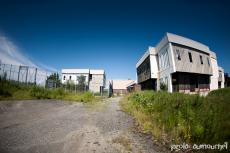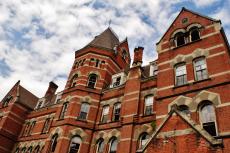Located in Sherbrooke near the 410 Highway, the Relais St-Francois is a former center for young offenders and now abandoned. Completely ransacked, the building doesn't have much interest. Water damages have been made by time, but I must admit...
The abandoned Forest Haven Asylum
"Yet while I live, let me not live in vain."
The words are inscribed on a weathered bronze plaque, marking the entryway to the administration building at Forest Haven Asylum.
Located in Laurel, Maryland, the Forest Haven Institute was notorious for its poor conditions and abuse of patients. In fact, it was reported to be in the top 10 worst cases of institutional abuse in all of U.S. history.
Opened in 1925, Forest Haven was reserved for the children and teenagers who had become lost in the system, unable to function in public schools and lacking the resources to pay for private care.
In fact, at its beginning, Forest Haven Asylum was a progressive institution, a farm colony that taught people with intellectual disabilities useable skills and aimed to get them gainfully employed. Residents milked cows, planted and tended to crops, and lived in dorms surrounded by trees.
In the 1960s, Forest Haven languished. Funding for its athletic and recreation programs dried up, and residents suffered greatly. Among the worst affected were residents who weren't mentally disabled at all - some were severely epileptic, others had similar disabilities that kept them from being functional outside the asylums gates. Once physically able, their bodies withered away for lack of activity, and many became bedridden.
In the late 1980s it became clear that Forest Haven was underfunded, poorly run and downright dangerous. Mentally ill children were choking on their feeding tubes and being buried unceremoniously on the banks of the Patuxent river. Once the lawsuits mounted and the citizens of DC began to call for serious reform, the government took steps to decentralize the system and placed patients in smaller hospitals closer to their homes. In October of 1991 the children were loaded into vans, the employees took their belongings and Forest Haven’s twenty-some buildings were forgotten.
Today Forest Haven lies in a no-man’s land between two highways, untouched by the DC government since its hasty evacuation. It is invisible from any major road and far from any public transportation, which has helped to preserve the medical records, prescription drugs and broken children’s toys that remain strewn about the grounds. There are no fences, no guards and no signs marking what this once was or even that it is something worth remarking upon.
Related content
Closed in 2003 and now abandoned, the Hudson River State Hospital is a former New York state psychiatric hospital which operated from 1873. Designated a National Historic Landmark due to its exemplary High Victorian Gothic architecture, the first...
Built in 1875 in the Ahuntsic-Cartierville district located in the north of Montreal, Berri house is Second Empire style and has been part of the development of the sector, which began in the late nineteenth century. The city took possession of...
Jewel of Quebec's heritage, the seigniorial manor was built in 1795. Expanded several times over the years, it was used for several purposes. From 1967 to 2000 it was used as a high school and later, Quebec police organization “Sûreté du Québec”...























